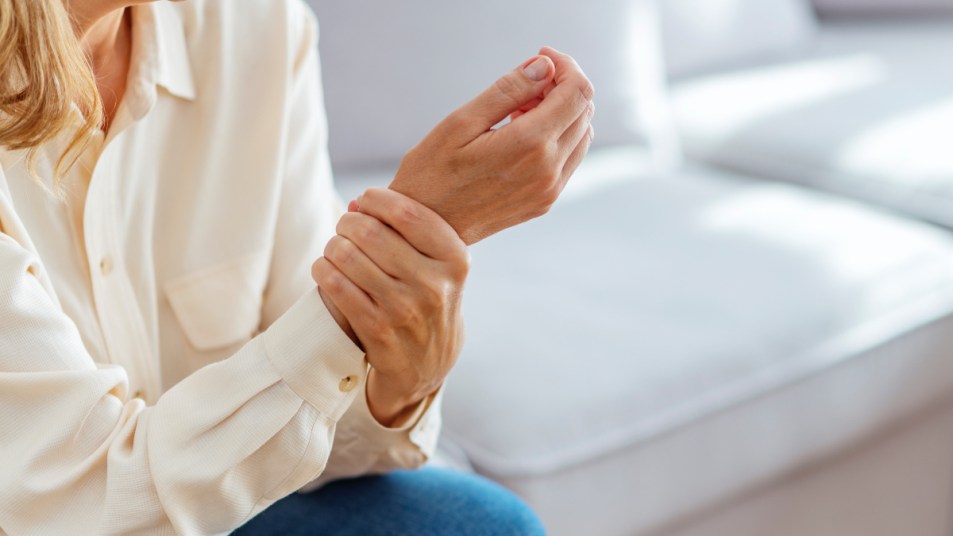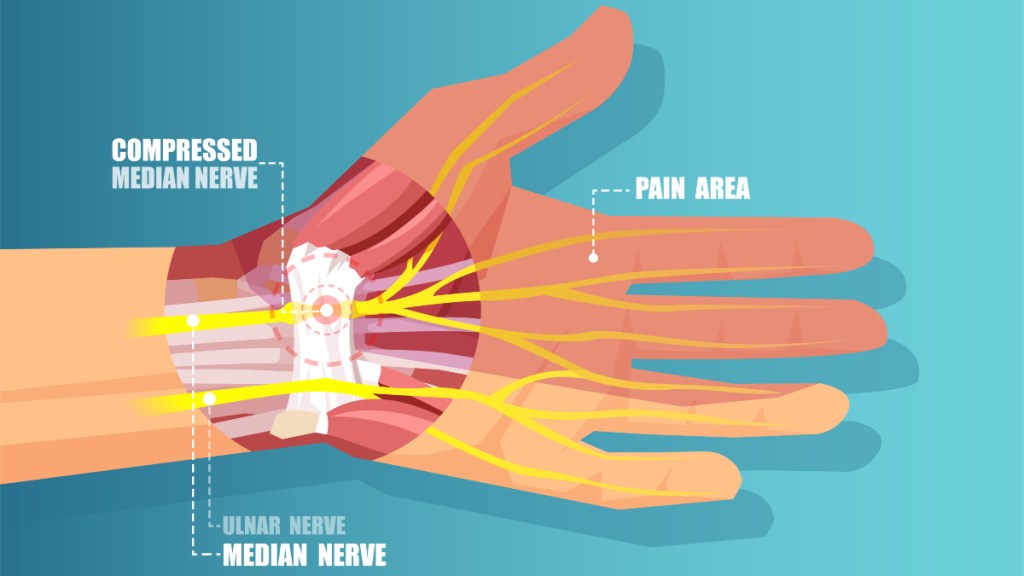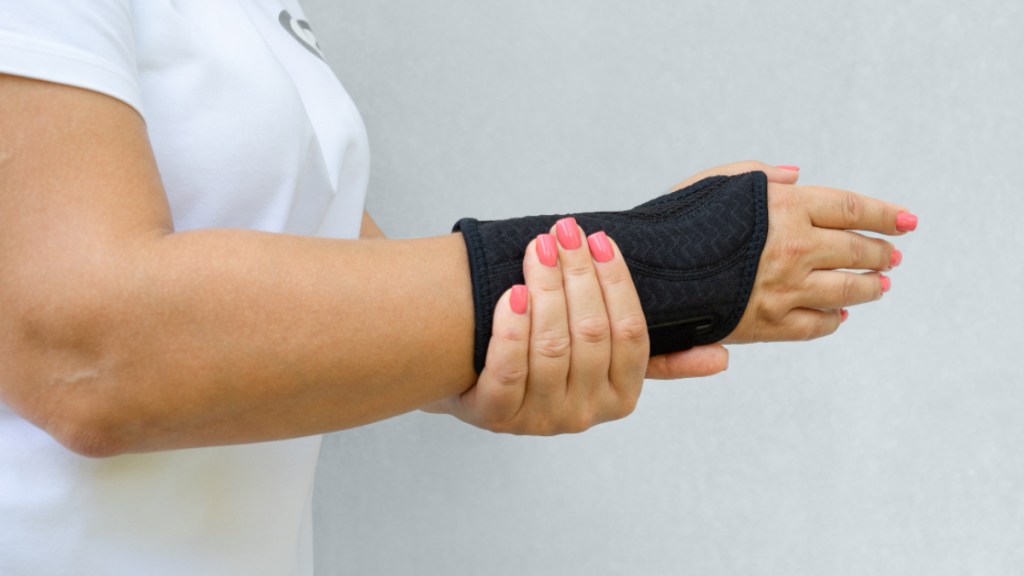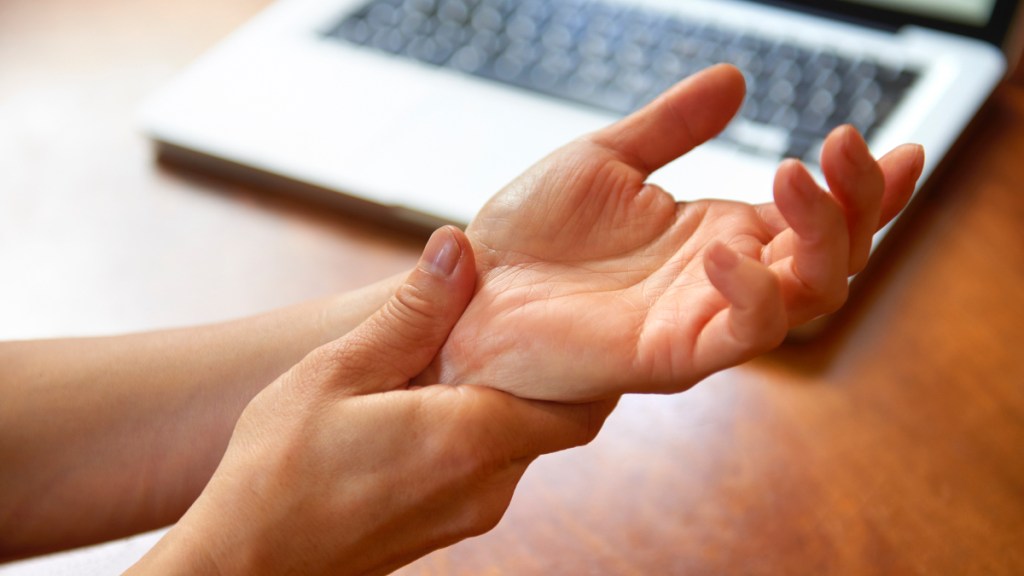These Carpal Tunnel Syndrome Self-Care Strategies Ease the Ache Without Surgery
An occupational therapist reveals whether heat or ice is better for carpal tunnel (the answer may surprise you!)

Starting to notice discomfort, numbness, weakness or tingling around your thumb and first two fingers? You could have carpal tunnel syndrome (CTS), a nerve problem that is often diagnosed between ages 40 and 60. Severe CTS may require surgery. But if your symptoms are mild to moderate, there are plenty of at-home strategies that can ease discomfort and potentially keep the problem from getting worse. You can get started today with these easy carpal tunnel syndrome self-care tips.
Understanding carpal tunnel syndrome
Carpal tunnel syndrome is a condition caused by compression and inflammation of the median nerve, the nerve that helps you move your hand, fingers, wrist and forearm.
“It can lead to symptoms of pain, numbness and tingling in the affected hand, specifically in the thumb, index finger, middle finger and a portion of the ring finger,” says M. Ramin Modabber, MD, an orthopedic surgeon at Cedars-Sinai Kerlan-Jobe Institute in Los Angeles, CA. That can make it tougher to do simple, everyday tasks like buttoning your shirt or using a key to unlock a door.
CTS happens when your median nerve gets squashed or damaged from excess pressure. It can develop from a wrist injury, performing repetitive motions with your hand or wrist (like using a computer or knitting) or frequently using vibrating tools (like a drill if you’re big into DIY home improvement projects).

Why women are more at risk for CTS
You might’ve heard that using a computer can make you more prone to carpal tunnel syndrome. While that’s true, it’s far from the only factor. Hormonal shifts that occur during menopause may raise CTS risk, possibly by increasing inflammation of the median nerve, experts theorize. So it makes sense that the condition affects women three times more often than men. (Click through to see the 7 best menopause treatments that work to ease symptoms head to toe.)
Certain health conditions can factor in, too. “Because CTS is characterized by inflammation, people with rheumatoid arthritis, diabetes or high blood pressure may have an increased CTS risk,” adds Dr. Modabber.
Can carpal tunnel syndrome self-care work for you?
CTS that causes mild to moderate symptoms (meaning they’re annoying but don’t have a major impact on your daily life) can usually be managed at home, perhaps with the addition of some physical therapy. But it’s a good idea to have the problem checked out so you and your doctor can decide on the best way to treat it.
“The best approach to CTS is to have it evaluated as soon as possible,” Dr. Modabber says. “CTS tends to worsen if pressure on the median nerve continues over time, so proper diagnosis and a treatment plan are essential.”
It’s also worth making sure you’re actually dealing with CTS and not another problem that can cause similar symptoms, such as tendonitis (inflamed tendons).
Carpal tunnel syndrome self-care strategies
Ready for some serious wrist relief? These expert-backed self-care tips can get pain, numbness and tingling from carpal tunnel syndrome in check.
1. Sleep with a splint
Adjustable wrist splints, which keep your wrist in a neutral position to prevent it from bending and causing painful median nerve compression, are the #1 self-care tool for easing carpal tunnel syndrome symptoms at home.
“Many of my patients experience so much relief after wearing one,” says Jodie Auliff, OTR/L, an occupational therapist and lead hand therapist at Athletico Physical Therapy in Marengo, IL. One to try: FEATOL Wrist Brace for Carpal Tunnel (Buy from Amazon, $10.86).
You can start by strapping on your splint before you go to bed. “We tend to curl our wrist down while sleeping, causing more pressure on the median nerve,” Auliff says. But for even better results, you can also wear the splint during the day. This helps you avoid compressing your median nerve while doing everyday activities like typing or picking up a bag of groceries.

2. Try ‘nerve gliding’
Next to splinting, physical therapy exercises are one of the best carpal tunnel syndrome self-care remedies to help take the pressure off of your median nerve. Median nerve glides (also known as “nerve flossing”) are one of Auliff’s favorites that you can do at home. Here’s how:
- Make a fist with your thumb flexed straight.
- Straighten out your fingers.
- Spread your thumb away from your fingers.
- Gently bend your wrist back toward your arm far as you can tolerate (as if you were holding a tray of food).
- Hold this hand position and turn your palm to face you.
- Hold this hand position and use your opposite hand to gently stretch your thumb. Do 10 reps total, stopping sooner if your symptoms start to worsen. Repeat three times per day.
For a visual guide of a similar technique, check out this short video below:
3. Practice your downward dog
Yoga poses that stretch and strengthen your upper body, like downward facing dog, can be as effective as splinting for managing CTS pain, found a study in the journal JAMA.
“Yoga promotes better circulation, which can help reduce inflammation and alleviate symptoms associated with carpal tunnel syndrome,” explains Angel Desantis, Course Instructor for ISSA Yoga & Wellness Academy in Phoenix, AZ. “Specific poses can also increase flexibility and strength in the upper body, relieving tension and supporting the wrists and hands.” To try downward facing dog at home:
- Start on your hands and knees with your wrists aligned under your shoulders.
- Lift your hips toward the ceiling, straightening your arms and legs.
- Press your palms into the mat, keeping your fingers spread wide.
- Hold for 30 seconds to 1 minute, breathing deeply. Repeat daily.
For a visual guide, check out the video below:
4. Go hot or cold
“One of my most asked questions is: Hot packs or cold packs?” Auliff says. It turns out, there’s no one-size-fits-all answer. “Heat tends to be most helpful for carpal tunnel, but some people response better to cold. Both can help with pain.”
Applying a hot pack can relax the muscles and tendons around your median nerve to make you more comfortable, while cold packs are better for alleviating swelling caused by fluid compressing your median nerve. “I recommend first trying heat and if it doesn’t help, then try a cold pack,” says Auliff.
One to try: WellWear Hot/Cold Reusable Gel Bead Pack (Buy from Amazon, $7.27). It can be warmed in the microwave or chilled in the freezer. Cover the pack in a tea towel and apply it to your wrist for 20 minutes at a time, a few times per day. (Tip: Click through to see how heat and ice can help if you’re suffering from sciatica, too.)
5. Supplement with B6
“Vitamin B6 is thought to help with nerve health and nerve recovery,” Dr. Modabber says. Taking 120 mg of the vitamin daily for three months can reduce pain, numbness and tingling, make it easier to perform daily activities, and even reduce nighttime wake-ups from CTS, found a study in Advanced Pharmaceutical Bulletin. You’ll reap the biggest benefits when you take B6 while trying other lifestyle strategies like wearing a splint and performing wrist exercises, Dr. Modabber adds.
6. Rub your wrist
Sounds simple, but it works like a charm! “Massaging your wrist can be helpful for pain relief as well as increasing blood flow to the area,” Auliff says. Holding your wrist with your opposite hand, use your thumb to apply firm but gentle pressure to the inside of your wrist while making circular motions.

You can massage the area for a few minutes as often as carpal tunnel syndrome self-care is needed. “Use a good massage lotion so there is no friction on the skin causing irritation,” Auliff suggests. One to try: BIOTONE Dual-Purpose Massage Cream (Buy from Amazon, $18.95). It comes in a handy tube that you can toss in your bag for relief on the go.
For more ways to soothe achy joints from head to toe:
Knee Pain When Bending? These 8 MD-Approved Tricks Help End the Ache Naturally
13 Best Hand Massagers for Arthritis, Carpal Tunnel, and Stiff Joints
Experts Identify the Surprising Culprit Behind Hip Pain + Relaxing Strategies to Soothe It Fast
This content is not a substitute for professional medical advice or diagnosis. Always consult your physician before pursuing any treatment plan.

















